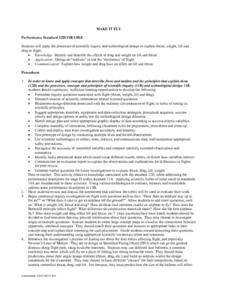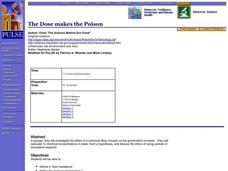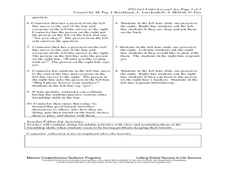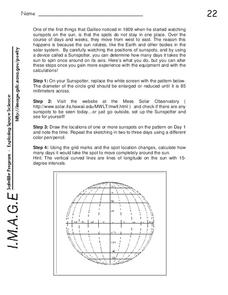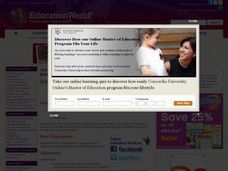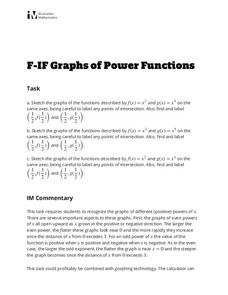Curated OER
Local Government: Caring for Your Community
Seventh graders investigate the role of local governments. In this government lesson, 7th graders examine historical photographs and determine what services are being performed in the photographs. Students research how the...
Curated OER
Sharing is Caring
Learners sharpen their problem solving skills. In this service learning lesson, students work collaboratively to solve a problem involving scarcity.
Curated OER
MAKE IT FLY
Young scholars utilize the process of scientific inquiry and technological design to explain thrust, weight, lift and drag in flight. They design an "airplane" to test the "mechanics" of flight. In addition, they brainstorm and sketch a...
Curated OER
The Dose makes the Poison
Young scholars investigate the effect of a chemical (they choose) on the germination of seeds. They calculate % chemical concentrations in water, form a hypothesis, and discuss the ethics of using animals in biomedical research.
Curated OER
Performance of routine movements
High schoolers explore movement in dance routines. They observe movements and transform everyday gestures into choregraphy. Through activities, students develop improvisational skills. They evaluate and critique work.
Curated OER
Terrarium Observation
Students observe the growth of plants in their terrarium. In this social studies lesson plan, students measure plant growth for several weeks. They predict what happens if other organisms are added in the terrarium.
Curated OER
Snail Observation Exercise
Students are given a pond snail in a clear glass and asked to make observations on the snail's form and behavior. One of the key ideas is that seemly common subjects (like snails) often have surprising or interesting properties.
Curated OER
Making Community Measurements: Which Plant Part?
Students identify a plant in a given community and make a variety of measurements. They determine how a plant meets its basic needs. In addition to identifying plant parts, they observe seasonal change and compare plants within a community.
Curated OER
The Art of Making Paper
Students discover the materials used to make paper in the late Middle Ages and coompare that to papermaking today. In groups, they analyze and compare the effectiveness, cost and value of the various materials available. They discuss the...
Curated OER
Meadows Observations
Learners investigate and examine the different living things they find in a meadow. Students record the different colors that are present and create a graph, identify and label parts of a plant, use a magnifying lens to examine all ...
Curated OER
The Rewards of Caring
Students explore the concept of democracy. In this character education lesson, students discover enlightened self-interest and discuss a quote from Alexis de Tocqueville.
Curated OER
Saving Makes Cents
Students identify ways families save money. In this financial lesson, students read the book A Chair for My Mother and discuss ways to save money. Students identify coin values and practice counting money.
Curated OER
Friendship Line Dancing
First graders explore the characteristics of being a good friend. They observe a puppet and discuss why the puppet is sad. In groups, 1st graders form two lines, facing each other. They practice talking to each person in the line,...
Curated OER
Sunspots and the Sun's Rotation
For this sun worksheet, students use a Sunspotter to observe the rotation of the sun by identifying the presence of sunspots and watching them rotate over time. Students calculate how many days it takes to see the sunspots they observe...
Curated OER
Backyard Critters
Students explore the characteristics of invertebrates in their backyards. They observe, describe, and classify specimens. They conclude with a "snail race."
Curated OER
Density Demonstration: Coke vs. Diet Coke
In this density demonstration, students compare a can of diet coke to a can of regular coke. They list the similarities and differences of each prior to the demonstration. The cans are placed in a tank of water and students record their...
Curated OER
Home Living / Daily Living: Personal Hygiene—Use of Napkin
Staying clean is a big part of staying healthy and looking good in the community. Personal hygiene and napkin use are the focus of this activity. Your class will eat a messy food, look in a mirror to see if their face is messy, then...
Curated OER
Chapter 1: The Science of Biology
Provide young biologists with everything they need to excel in the study of lymphatics, the nervous system, hormones, cellular division, and more! Pupils utilize the workbook, complete with end-of-chapter assessment worksheets, to...
Curated OER
Unit 21 Terrariums
The history of terrariums and how to construct one are presented in this PowerPoint. Each important step aspect of terrarium care is discussed: selecting a container, drainage, soil, types of plants, and maintenance. You will want to...
Curated OER
Lesson Plan 18: Cleaning It Up
Careful proofreading is an important step in the writing process. After guided practice using a provided worksheet that details common grammar concepts, young writers refer to the worksheet as they proofread their own work....
Curated OER
Outgroup Experiment Reveals Bias, Stereotyping
Exploring bias and stereotypes, learners dress up as members of "outgroups" (groups of people who are often judged). Though the lesson specifies that it should be "respectful and not mock the outgroup in any way," this activity would be...
Curated OER
What Are You Eating?
Discover the calorie content of foods by observing how much heat they produce in water. If you have a calculator-based laboratory (CBL™) insturment for collecting data, then this laboratory worksheet will not need any changes. If...
Illustrative Mathematics
Graphs of Power Functions
This activity consists of three exercises in which learners sketch the graphs of various power functions on the same axes. They use their sketches to make comparisons and observations which lead to generalizations about the graphs...
Curated OER
The Alphabet Garden
Third graders transplant, tend and observe a plant for each letter of the alphabet in a school garden. They work individually to research and select a plant that will grow in their local climate. Students then care for and observe the...


